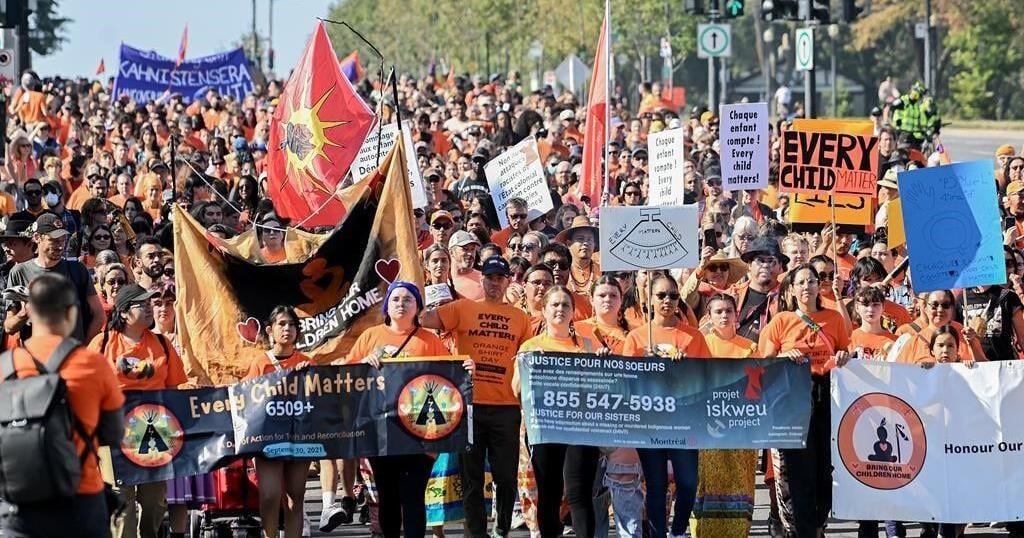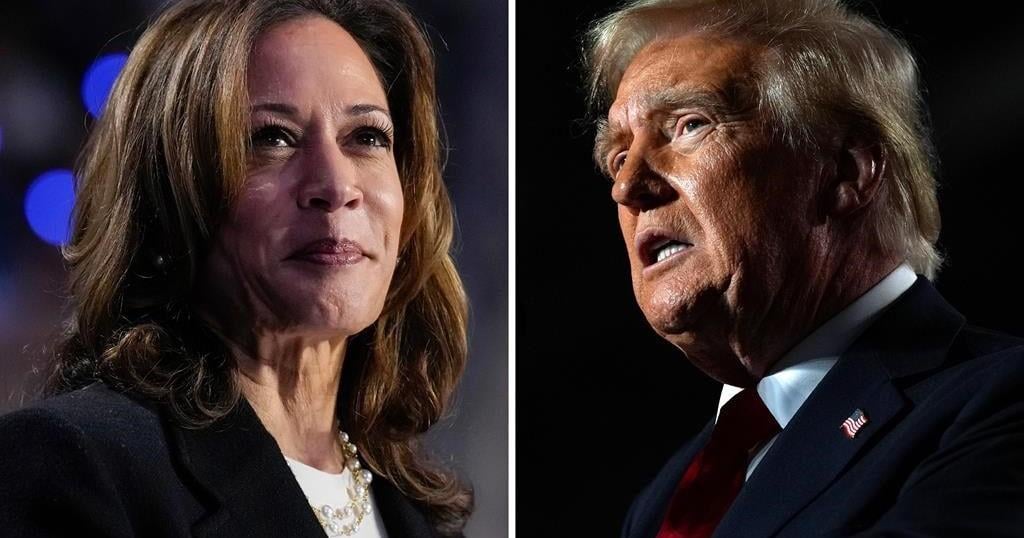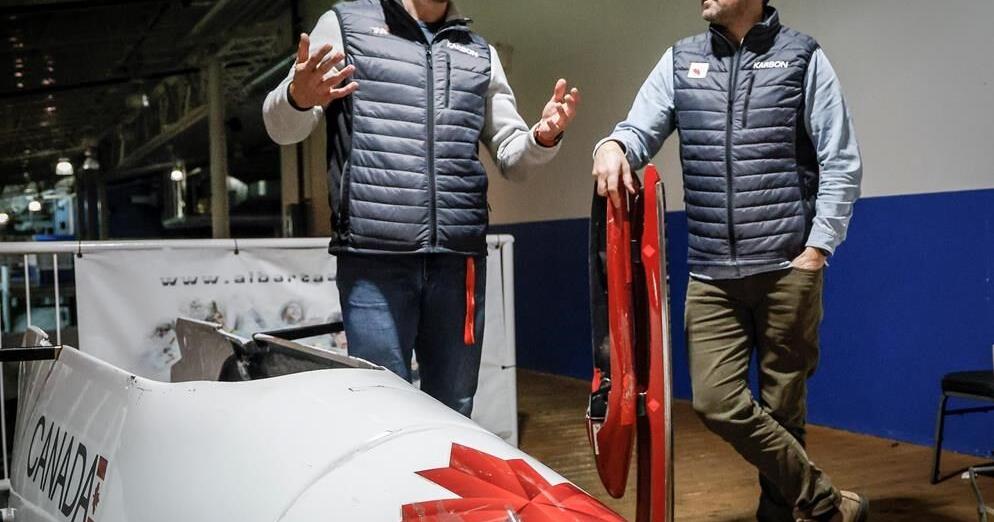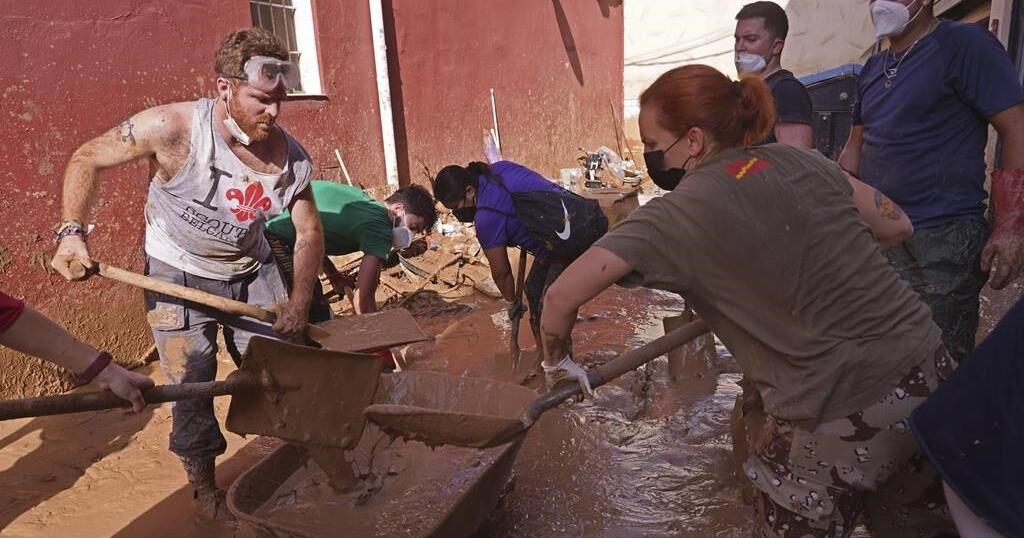OTTAWA – The smell of sage and sweetgrass floated in the air Monday over a mostly sombre ceremony to reflect on the legacy of residential schools and remember those who survived — and the thousands who didn’t.
But amid the more difficult moments at the National Day for Truth and Reconciliation ceremony on Parliament Hill Monday came a few moments of levity and celebration.
“We’ve got tomorrow, we’ll live for a brighter day,” sang Diyet & the Love Soldiers performing their song We’re Still Here, while dignitaries and children alike got up on their feet and started dancing.
Ribbon skirts twirled and orange shirts blazed through the crowd under the heat of a late September sun and a nearly clear blue sky.
Gov. Gen. Mary Simon, her orange T-shirt clearly visible under a black pantsuit, stood clapping in the middle of a circle of people dancing.
Immigration Minister Marc Miller was passed a hand drum by a woman in the crowd and began to play along as House of Commons Speaker Greg Fergus bounced up and down to the beat. At one end of the growing circle a young girl danced holding hands with a woman in a bright orange T-shirt reading “I’m a residential school survivor.”
Crowds gathered on the lawn in front of Centre Block Monday to remember and reflect.
More than 150,000 children were forced to attend residential schools, and many survivors detailed the horrific abuse they suffered at the Truth and Reconciliation Commission.
An estimated 6,000 children died while attending the schools, although experts say the actual number could be much higher.
Most in attendance in Ottawa were wearing the orange shirts that have come to be a symbol of reconciliation, inspired by the story of residential school survivor Phyllis Jack Webstad, who has recounted having a brand new orange shirt taken from her on her first day at a residential school and never having it returned.
“The residential school system was intended to destroy us, and they did not succeed,” said Stephanie Scott, the executive director of the National Centre for Truth and Reconciliation, to roaring applause.
“Our children suffered in those institutions, and to this day, their spirits call out to all of us to be remembered and honoured.”
After Scott addressed the crowd, a red banner carrying the names of children who died in residential schools made its way toward the stage. People stood up as it passed in a show of respect.
It was one of numerous ceremonies across Canada Monday to mark a day that officially began in 2021, fulfilling one of the calls to action in the Truth and Reconciliation Commission report.
In Charlottetown, Premier Dennis King invited the chiefs of the Mi’kmaq First Nations and the public to the Provincial Administration Building for a short reflection followed by lowering the flags to honour the lives of Indigenous Peoples affected by the residential school system.
The province also planned to shine orange lights on the building after sunset.
In Fredericton, Amanda Myran Dakota of Wolastoqey First Nation sat with her elders, holding her drum which she would later play at the ceremony there.
She said since Truth and Reconciliation Day was created in 2021, “there have been some baby steps, but there is a lot of work that has to happen.”
Dakota pointed to the number of Indigenous children in foster care as indicative of being a “modern-day residential school.”
A loud, boisterous sea of orange marched through Montreal to mark the day after a ceremony at the foot of Mount Royal.first gathering at the foot of Mount Royal to listen to number of speakers including Indigenous musician Jeremy Dutcher and Kevin Deer, an elder from Kahnawake Mohawk Territory near Montreal who performed a ceremony to begin the event.
Na’kuset, executive director of the Native Women’s Shelter of Montreal and an organizer of the event, said she hoped to see more young people get involved in the movement.
She noted the Truth and Reconciliation Commission report has been around for nearly a decade, but only 11 of the 94 calls to action have been implemented.
“So who’s going to do it if the adults now, the current government, isn’t going to implement them? We’re hoping that next generation is going to do it,” she said. “It’s really hard to get the government to move, and I’m really not patient so, I’m hoping to have people inspired today by these incredible speakers that are going to share knowledge they would not get anywhere else.”
Noëlla Mckenzie, an Innu elder and residential school survivor, told those gathered at the foot of Mount Royal that she came for the same reason others did.
“We are stronger together,” Mckenzie said.
“I’m proud today because I spent 10 years in a residential school … I told myself we must always give hope to our kids of the future, so that they know what we’ve experienced.”
In Toronto, a crowd gathered at Nathan Phillips Square outside city hall, most wearing orange shirts and traditional Indigenous clothing, as musicians beat drums, a dancer performed and speakers delivered speeches on the stage.
“I am here because this an important day for all Canadians,” said Sarita Censoni who visited the square with her friend.
“It is a time for us to heal, to help our Indigenous communities, to move forward, to understand there is no truth without reconciliation.”
Riscylla Shaw, a grandchild of a residential school survivor, said the residential school system a painful part of not only history but also present-day Canada.
“It’s a very painful part of our present,” she said. “It is a very painful part of the current way of being that so many indigenous communities don’t have fresh water, don’t have access to health resources, education resources, fresh food.”
Shaw said it was heartwarming for her see so many people marking the day.
“It also is really meaningful to see so many people here in orange shirts, to see the support,” she said.
In British Columbia, where a provincial election campaign is underway, the main party leaders turned their attention to Truth and Reconciliation Day but with a clear political lens.
B.C. Conservative Party Leader John Rustad said if his party were elected the province would partner with First Nations to find prosperity through resource projects.
NDP Leader David Eby attended an Orange Shirt Day ceremony at the University of B.C., while Green Leader Sonia Furstenau held a news conference to warn that some of the of the party leaders want to “undo” the progress the province has made on Indigenous rights.
Furstenau was referring to Rustad’s previous pledge to repeal legislation on B.C.’s adoption of the United Nations Declaration on the Rights of Indigenous Peoples.
Prime Minister Justin Trudeau travelled to Inuvik, N.W.T. to take part in events there. He was represented in Ottawa by many in his cabinet including Crown-Indigenous Relations Minister Gary Anandasangaree.
“It’s a day for enormous reflection,” said Anandasangaree, his words straining to be heard over the heartbeat of the drum playing behind him.
Conservative Leader Pierre Poilievre didn’t attend the event on Parliament Hill, electing to participate in a separate event with Indigenous leaders along with the party’s critic for Crown-Indigenous relations and Indigenous services MP Jamie Schmale.
In a statement, Poilievre recalled the “dark history of excessive government overreach” that brought long-lasting suffering to First Nations, Inuit and Métis communities.
“Indigenous peoples must have the freedom to determine their futures, preserve their languages, develop their resources, use their talents and celebrate their cultures,” he said. “Through a new approach and through the unmatched resilience of Indigenous people, Canada can achieve reconciliation and a brighter future for all.”
-with files from Michael MacDonald in Halifax and Hina Alam in Fredericton, Sidhartha Banerjee in Montreal, Sharif Hassan in Toronto and Darryl Greer and Brenna Owen in Vancouver.
This report by The Canadian Press was first published Sept. 30, 2024.

























